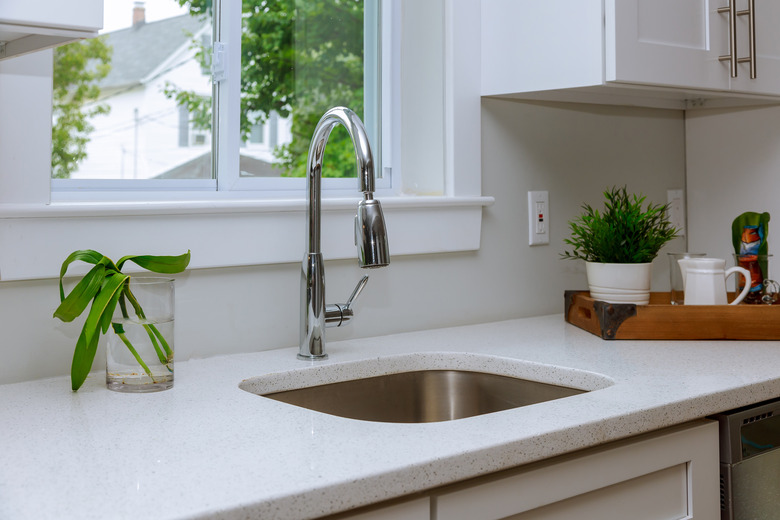How To Dissolve A Food Clog In The Kitchen
We may receive a commission on purchases made from links.
It can happen in the best of kitchens and particularly in busy ones. Clogs form in kitchen sinks due to a buildup of grease, grime and food particles. When water continues to build in the sink with no clear view of what is causing the stoppage, it could be a clog in the sink below the drain. Fortunately, there are a few ways to naturally and safely dissolve a food clog in the kitchen sink.
Using Vinegar and Baking Soda
Using Vinegar and Baking Soda
For smaller food clogs in the kitchen, a simple solution of vinegar and baking soda can break down the organic goo and save you from bigger issues. The benefits of using baking soda and vinegar when cleaning out a kitchen sink clog is that the mix will do double duty and clean the drain and bottom of the sink as well. Home Depot suggests a mix of 1 cup of fresh baking soda sprinkled down the drain followed by 1 cup of plain white vinegar.
Cover the sink hole with a rubber stopper or plate and allow the mixture to work for about 15 minutes. Remove the drain cover and run hot water down the sink for a few minutes. This should completely take care of most minimal kitchen sink clog problems.
Dissolving Stubborn Kitchen Clogs
Dissolving Stubborn Kitchen Clogs
Clogs that are located above the garbage disposal mechanisms will need to be removed by hand. A wet-dry vacuum works well to suck up clogs that can either damage the garbage disposal or have jammed the garbage disposal.
If the kitchen sink has a garbage disposal, make sure that it is turned off or unplugged. Reach into the sink and remove as much of the kitchen clog that you can by hand. Use gloves to protect your fingers from the blades and mechanical parts of the garbage disposal. Run your fingers around rims and the sides of the sink hole to thoroughly remove as much of the clog as possible.
To use a wet-dry vacuum, follow the manufacturer's instructions and set it up close to the sink. Place the hose end over the drain and create a tight seal around the end of the hose and the drain. For double sinks, seal up the opposite side of the sink with a rubber stopper to ensure you get good suction. Turn on the vacuum to dislodge the clog. It may not take long, so don't leave the wet-dry vacuum unattended during this process.
Commercial Cleaners to Remove Clogs
Commercial Cleaners to Remove Clogs
A clogged garbage disposal may need more work to dislodge. Liquid-Plumr suggests using a kitchen plunger, which is not the same as the type of plunger used to unplug a toilet. Under the sink, place a clamp over the rubber part of the drain line that connects to your dishwasher. Place the plunger completely over the sink drain to seal and fill the basin with water to about 4 inches. Plunge vigorously until the clog is sucked free, which can take a few minutes.
If you don't have a kitchen plunger or a lot of time, a few pours of Liquid-Plumr down the drain will not only remove the stubborn clog but also clean out the drain.
